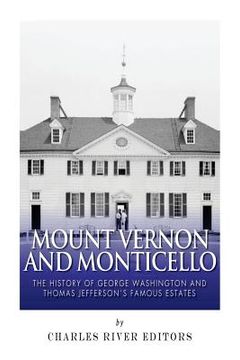Mount Vernon and Monticello: The History of George Washington and Thomas Jefferson's Famous Estates (en Inglés)
Reseña del libro "Mount Vernon and Monticello: The History of George Washington and Thomas Jefferson's Famous Estates (en Inglés)"
*Includes pictures *Includes accounts of the estates' histories and construction made by Washington and Jefferson *Includes online resources and bibliographies for further reading *Includes a table of contents For about as long as George Washington has been famous, so has his most famous residence, the spacious Virginian plantation known as Mount Vernon. Washington lived in a smaller structure on the land as a teen, and ironically, tradition and inheritance suggested that George would never be the one to own the land. Of course, fate would intervene, and Washington would not only come into possession of the 10,000 acres in 1761 but build and renovate the property to create one of the most famous private residences in the nation. Washington would live at Mount Vernon before the Revolution and retire there after the war and after his presidency. Indeed, he would die there and be buried there as well. By 1760, Washington was one of Virginia's wealthiest and most influential citizens, in large measure due to Mount Vernon's success as a tobacco plantation. However, to make that happen, Washington used hundreds of slaves, and though he mandated that his slaves be freed upon his death, the estate continued to employ slave labor until his widow's death years later. Thus, while Mount Vernon remains a hallowed tourist spot, it also underscores the most divisive and controversial issue of the post-Revolution era. Few Presidents are remembered for their homes, but Jefferson's Monticello is the greatest exception to that rule, and to this day it remains one of the nation's most instantly recognizable landmarks. When Jefferson's father died in 1757, his father's estate was split between Thomas and his brother, Randolph. Jefferson's share equated to about 5,000 acres of land and between 20-40 slaves. Because his father died when Thomas was only 14, he was not able to legally take hold of this estate until he was 21. Once Jefferson took formal control of the land, he began constructing his personal estate. Having received the schooling befitting of a gentleman during the late Enlightenment, Jefferson had a broad liberal arts education. This gave him some knowledge of architecture. Jefferson himself thus designed Monticello in a neoclassical mold. He avidly studied the Italian architect Andrea Palladio, and Jefferson's style can therefore be broadly characterized as Palladian. The construction of Monticello began in 1768, but it remained an ongoing project for many years. He formally moved into Monticello in 1770, and his wife Martha joined him there in 1772 after they were married. The time Jefferson subsequently spent in Europe also affected Monticello. He marveled at the architectural arts of the continent and studied them closely, which only strengthened his love for classical architecture and gave him ideas on how to expand his own estate. Ironically, although he had been wealthy all his life (or perhaps even because of it), Jefferson was a notorious spender who never learned how to operate a budget. During the twilight of his life, debt was a recurring issue, in large part due to expenses incurred by his work on Monticello and the University were enormous, and they ultimately depleted his considerable wealth. Mount Vernon and Monticello tells the story of the residence most associated with the first president, and the controversial nature of the slave labor used there. Along with pictures of important people, places, and events, you will learn about Mount Vernon like never before, in no time at all.

